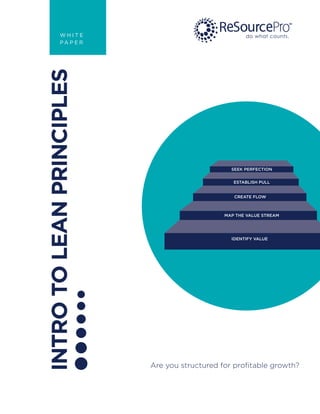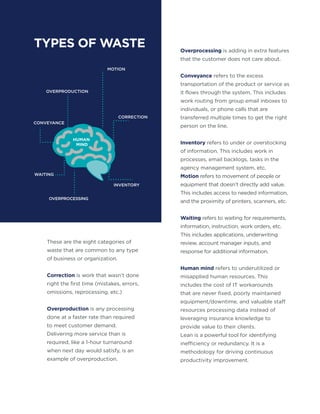Intro to lean principles
- 1. INTROTOLEANPRINCIPLES Are you structured for profitable growth? do what counts.W H I T E P A P E R IDENTIFY VALUE MAP THE VALUE STREAM CREATE FLOW ESTABLISH PULL SEEK PERFECTION
- 2. All insurance organizations are subject to the ebb and flow of market conditions, and many are constantly tasked with doing more with less. While these organizations may not control the market and its pricing fluctuations, they can manage their costs and in turn their bottom line. The traditional way of looking at cost has been Cost + Profit = Revenue. In certain, inevitable market conditions, insurance organizations do not control price or commission percentages, and they see their profits diminish as their costs increase. Desperate times do not always call for desperate measures, but they certainly require innovative thinking. ReSource Pro's Innovation Advisory Council (IAC)* has found that the principles of Lean theory bring a new perspective to this equation. LOOKING AT COSTS WITH LEAN EYES When insurance organizations do not control the price in the marketplace, focus is shifted to the cost of doing business. Looking at cost through “Lean” eyes, Revenue - Cost = Profit. This equation puts the control back into the insurance organization's hands, allowing them to control their costs and maintain profits while riding the wave of low prices. There are many ways to start looking at lowering costs. Some are more drastic than others, some take longer to implement than others, and unfortunately, some come with hefty price tags that make these solutions more of a long term investment than an immediate fix. This is why ReSource Pro decided to invest in Lean techniques that promote quick, small changes, and generate incremental improvements that build up to big impacts in the long run. In an age where most businesses desire immediate solutions, Lean can meet that demand by showing quantifiable returns in a short period of time. See more @ ReSourcePro.com*
- 3. WHAT IS LEAN? WASTE NOT Lean is a management practice that considers the expenditure of resources for any goal other than the creation of value for the end customer to be wasteful, and thus a target for elimination. In more basic terms, more value with less work. Lean Theory has developed from Toyota's philosophy of Lean Manufacturing that revolves around wasteful, necessary, and value-added work performed during a process. Value-added work is what an organization's customers are willing to pay for. This work is essential to the product or service produced and delivered to the customer, so it doesn't include things like re-work or error correction. Unfortunately, if we analyzed the work done in many insurance organizations, we would find that much of what occurs is ineffective, inefficient, and constitutes more than 50% of work done. Other necessary work, or incidental work under present conditions, may be essential for executing tasks directly related to producing products or services. However, it adds no direct value from the customer's perspective. This type of work may include work required by the organization to meet business or regulatory requirements, such as completing FDA-required audits, activities required by law, statute or contract, input or documentation required by a carrier, OFAC checking, and processes to limit E&O risk. Waste is action that is not essential for the work being performed. This includes waiting, correcting mistakes, rework, overprocessing, unnecessary approval steps, etc. In many organizations, waste makes up 50% or more of all activities! VALUE-ADDED WORK WASTE OTHER NECESSARY WORK IDENTIFYING WASTE
- 4. MOTION OVERPRODUCTION CORRECTION CONVEYANCE WAITING OVERPROCESSING INVENTORY HUMAN MIND TYPES OF WASTE These are the eight categories of waste that are common to any type of business or organization. Correction is work that wasn’t done right the first time (mistakes, errors, omissions, reprocessing, etc.) Overproduction is any processing done at a faster rate than required to meet customer demand. Delivering more service than is required, like a 1-hour turnaround when next day would satisfy, is an example of overproduction. Overprocessing is adding in extra features that the customer does not care about. Conveyance refers to the excess transportation of the product or service as it flows through the system. This includes work routing from group email inboxes to individuals, or phone calls that are transferred multiple times to get the right person on the line. Inventory refers to under or overstocking of information. This includes work in processes, email backlogs, tasks in the agency management system, etc. Motion refers to movement of people or equipment that doesn’t directly add value. This includes access to needed information, and the proximity of printers, scanners, etc. Waiting refers to waiting for requirements, information, instruction, work orders, etc. This includes applications, underwriting review, account manager inputs, and response for additional information. Human mind refers to underutilized or misapplied human resources. This includes the cost of IT workarounds that are never fixed, poorly maintained equipment/downtime, and valuable staff resources processing data instead of leveraging insurance knowledge to provide value to their clients. Lean is a powerful tool for identifying inefficiency or redundancy. It is a methodology for driving continuous productivity improvement.
- 5. Innovation does not happen when everything around us is great. The best innovation takes place when we are forced to change. - Lisa Bodell Founder and CEO, futurethink WHY LEAN? WHY NOW? A LEAN LEAP MADE IN A CRISIS We believe this is the time to stand out from the crowd, crash competition, and build for the future. This is not the time for big spending, it is time to cut costs by re-engineering processes and redeploying people to do more value work. Restructure teams for growth. Focus the organization on what is valued by customers, delegate necessary work, and eliminate waste. Now, more than ever, is the time for insurance organizations to advance their Lean transformation towards operations excellence. Lean protects profit margins by improving quality and productivity, strengthens ties with customers by improving service, and converts orders-to-cash faster by reducing lead times. Most importantly, Lean gives the organization an enduring competitive advantage. Taiichi Ohno pushed the Toyota Production System through the entire Toyota Motor Company in 1950 during the great crisis that left Toyota on the brink of bankruptcy. It was post WWII, Japan's resources were limited, and there was no room for waste. The Toyota Production System, a Lean-based methodology, rescued Toyota and took the company to new heights. Here are a few ways that Lean transformation can be advanced across an enterprise: Developing employees as problem solvers through coaching initiatives Changing management culture from command and control to fact-based and flexible Transitioning from a tools-based implementation path to a course that applies Lean management as a complete business system Changing how the organization thinks and conducts business on a daily basis “ ”
- 6. do what counts. RESOURCE PRO 1180 Avenue of the Americas 16th floor New York, New York 10036 888.577.7552 www.resourcepro.com W H I T E P A P E R





